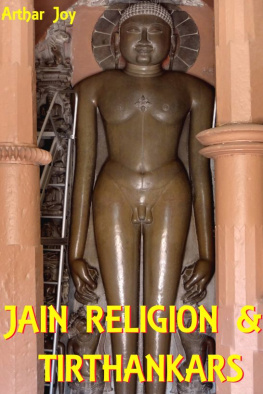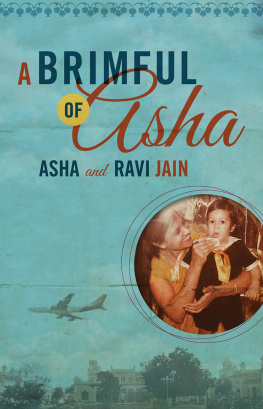Jain Religion & Tirthankaras
By Arthar Joy
Published by Mdsharma
Smashwords Edition
mds e-books 2014
Smashwords LicenseStatement
This ebook is licensed for yourpersonal enjoyment only. This ebook may not be re-sold or givenaway to other people. If you would like to share this book withanother person, please purchase an additional copy for each reader.If youre reading this book and did not purchase it, or it was notpurchased for your use only, then please return to Smashwords.comand purchase your own copy. Thank you for respecting the hard workof this author.
Preface
Jainreligion is one of the ancient religions of the world. Thisreligion is also discussed in ancient books like Srimad Bhagwad,Vishnu Puran, Padam Puran, Matsya Puran, and other ancientpurans.
JainGurus are also called as Jin, Jindev or Jinendra. From Jin wordJain word has been procured. Jin are those people who havesubdued their senses and are not harmful to any living creature.They are only called in appreciation of them as Arhant, Arihant andor Arhat.
There aretwenty four Tirthankaras in Jain religion and these tirthankarasare from these Arhants only. All these tirthankaras have takenbirth as a common man and after having subdued their senses alongwith having control over their mind and soul have becomeTirthankaras.
-Author
Table of Contents
1. Jain Religion
AccordingJain Religion success of any work is dependent on three basicthings i.e. they are dedication knowledge and deeds. Jain religiontells these three basis as proper insight, proper knowledge andproper deeds.
Samyag Darshan: To believe and have a trust in true Guru is calledas Samyag Darshan. It has got its 3 peculiarities and they are 1)Upsham 2) Ayosham and 3) Shaiyak.
It hasits twenty five defects; they are 1) Eight defect of doubts 2)Eight Madh defects of passion, 3) Six defects of Lack of efforts,4) Three defects of foolishness. Samyag Darshan people are freefrom the fear of earth and above, fear of diseases, free of thefear of death, free from rebirth, reputation in the world and etc..Free from all such fears.
Samyag Gyan: True knowledge is called Samyag Gyan. There are five goalsof this gyan, they are 1) Mati Gyan 2) Shrut Gyan 3) Avadhi Gyan 4)Man Paryapt Gyan and 5) Kewal Gyan.
Theknowledge or desire that takes place through ones sense organs andmind is called Mati Gyan.
Theknowledge gained by Mati Gyan to have specialized knowledge of theknowledge gain through Mati Gyan is called Shrut Gyan.
Theperson who acquires depth of knowledge after considering all hissurroundings, limitations and other things is called AvadhiGyan.
Theknowledge which knows about the entire universe spirituality andsoul is called Keval Gyan.
Samyagya Charitra - A person is said to have Samyagya Charitra whenhe quits five characteristics i.e. robbery, violence, lies, badvices and talking ill.
Sakal Charitra- The fasts perform by the saints if called NationalCharitra and the fasts performed by ascetics is called SakalCharitra (Entire conduct) Shravak vows for not doing any sins andthe ascetics behaves accordingly.
Jain Religion Practical Attitude Mahaveer has taught everyone to treatall living creatures equal and also told to his followers to havestrict self discipline and self control on one self. Mahaveer hasgiven importance and special place to non violence, truth andindependence in Jainsm.
Panch Mahavrat (Five Major Fasts) (1) They are 1 not to speak lives (2)To save life of every living creature (3) Not to keep attachmentswith any materialistic and non materialistic things of the world.(4) Not to take the thing that has not given to us. (5) To quitcompletely relationships with female.
Non Violence- Non Violence is the main root of Jainism. Henceall Jains are vegetarian, they even drink water by sieving it witha cloth, before walking they would clean of the floor so that noother living creatures is dead. They tie cloths on the mouth with athought while breathing in & out some minute living creatureshould not lose their life in their process ofbreathing.
Apartfrom the quality of kindness ought to be present in Jains. Mahaveerhas told four forms of this they are 1) To be happy on othersprogress 2) To help anyone without any expectations. 3) To keepsympathy towards people who commit sin. 4) To exercise theirefforts towards helping the sufferers to overcome theirproblems.
Mahaveerhas said six responsibilities for a Shravaks. 1) To do puja ofGod. 2) To worship Guru. 3) To have authority to self initiate. 4)Self Control. 5) Meditation and should also donate.
SacredVerse (Mantra) of Jains
OmkarVerse is regarded as the primary resource of JainReligion.
OmArihantanam
OmSidhanam
OmIriyanam
OmUvazayanam
Om LoyaSavsahunam
AlsoPanch Omkaaro, Sarva Pasanda Mangalana Ch.Savesi Padam. HawaiManglam.
Theysay:
Greetings(Namaskar) to Arihanto
Greetings(Namaskar) to Sri Siddho
Greetings(Namaskar) to Acharyas
Greetings(Namaskar) to Upadhyas
Greetings(Namaskar) to all saints of the world.
Thesefive Namaskars Mantra destroys all the sins and is very pious. Thismantra is also known as Navkar Mantra, Panch Namaskar Mantra, MahaMantra, Mantra Raj and Mangal Mantra. It is also said that fromthis Mantra itself 84 Lakh Mantras have been evolved. In thismantra there are 5 steps, 35 letters and 58 vowels. The mantra canbe read in 18, 432 different ways. This mantra has been said to beeternal Pushpdant Bhoobali as the writer of this mantra.
2. Deeds and Rebirth
Followersof Jain religion strongly believes in rebirth. Mahaveer, Parshwanaand other Tirthankaras have become Tirthankaras only after takingnumerous births. Jainisms principle of beliefs that by performinggood deeds one gets rebirth in good status family and by performingbad deeds one gets rebirth in lower families and also as some othercreature too.
Theperson who frees himself from all the deeds Samyagya drashti,Samyagya charitra and Samyagya gyan then for him his good deedsbecome nothing. He becomes Dev and is therefore called Jin, andsuch Jins who had formed religion by spreading their principles oflife that are to be followed are called asTirthankara.
Afterbecoming a Tirthankara they become free of the cycle of death andrebirth as after this they achieve salvation.
3. Festivals and fasts of Jainreligion
To keepfast is the normal routine of people of Jain religion and theirfasts are kept by them as a celebration. Paryushan is the mainfasting festival of Jains. It continues for eight days, and itcomes during rainy season. During Paryushan Jain people are onfasting; as such these people keep fast any time for example whenthey feel that they have committed some sin then they fast as arepent and apology in order to erase off their sin.
Saintssages, nuns and shravaks fast in order to balance their controlover their desires. Mahaveer emphasized on fasting as according tohim fasts purifies our body and head. Mahaveer himself wouldfrequently be on fasts for months together and stay hungry.According to Jainism leaving food alone is not enough as whilefasting one should even not desire of having food is important.They believe that if a person while fasting carves for food thenhis fast is not successful.
Some ofthe important festivals and fasts of Jain religion are:- Ekasan,Biyasan, Ayambil, Chatha, Atthama, Utthai, Santthara, Navkarsi,Raksha Bandhan, Gyan Panchami, Silence Ekadashi, Papush Dashmi,Akshay Tritiya, Anjan Shallaka, Dhwajropan, rath Yatra, SanghYatra, Malaropan, Porsi, Saadhporsi, Navpada olli andetc..
MahaveerJayanti
MahaveerJayanti is the festival celebrated as the birthday of LordMahaveer.
Diwali: Diwali is celebrated by people of Jain religion as the dayof eternal bliss of Mahaveer. It is said that on this day Mahaveerhad left his body achieving salvation, at that moment for a fewseconds the entire world and the universe had gone into utterdarkness, then Gods wiped off this darkness by lighting up theuniverse with some artificial light for the time being. Hence tilldate Diwali is celebrated by them by lighting candles in memory ofMahaveer and his eternal bliss.
Next page









